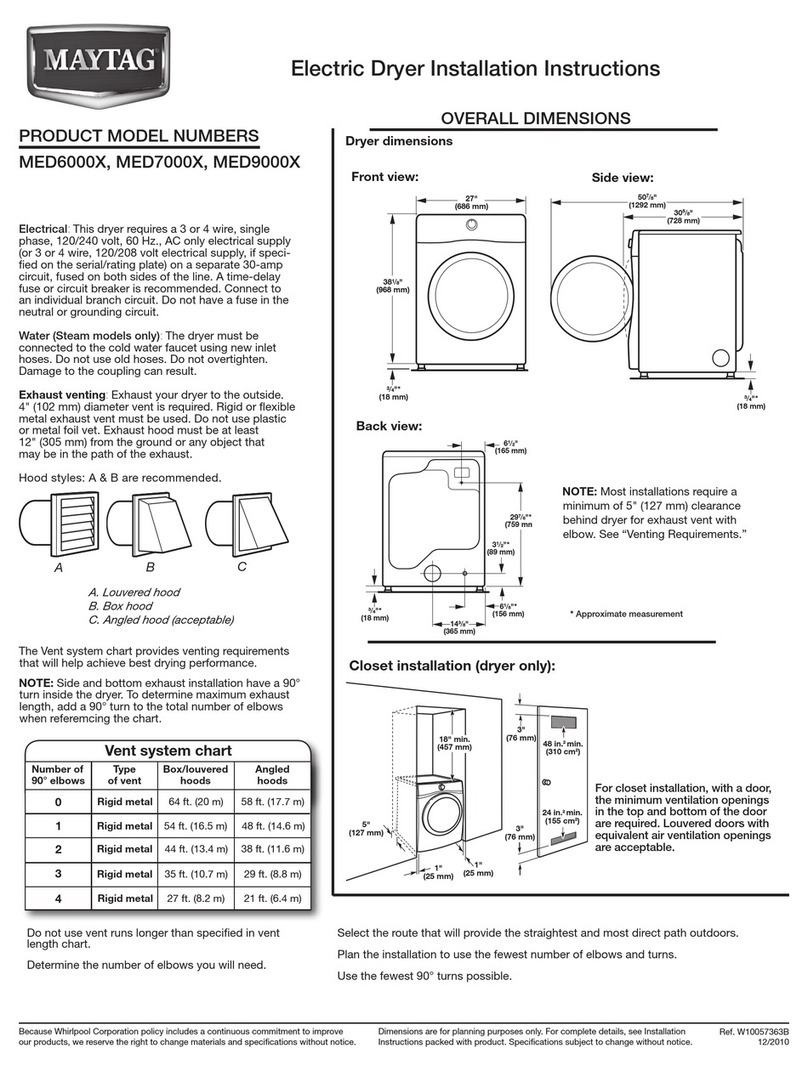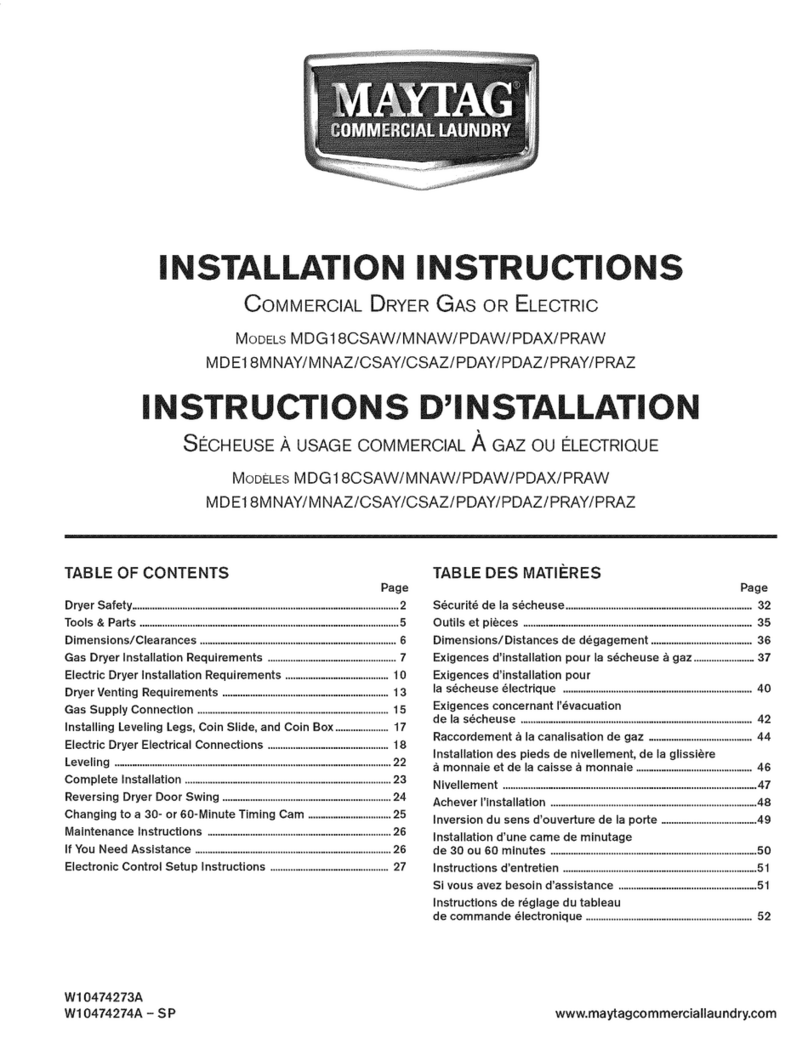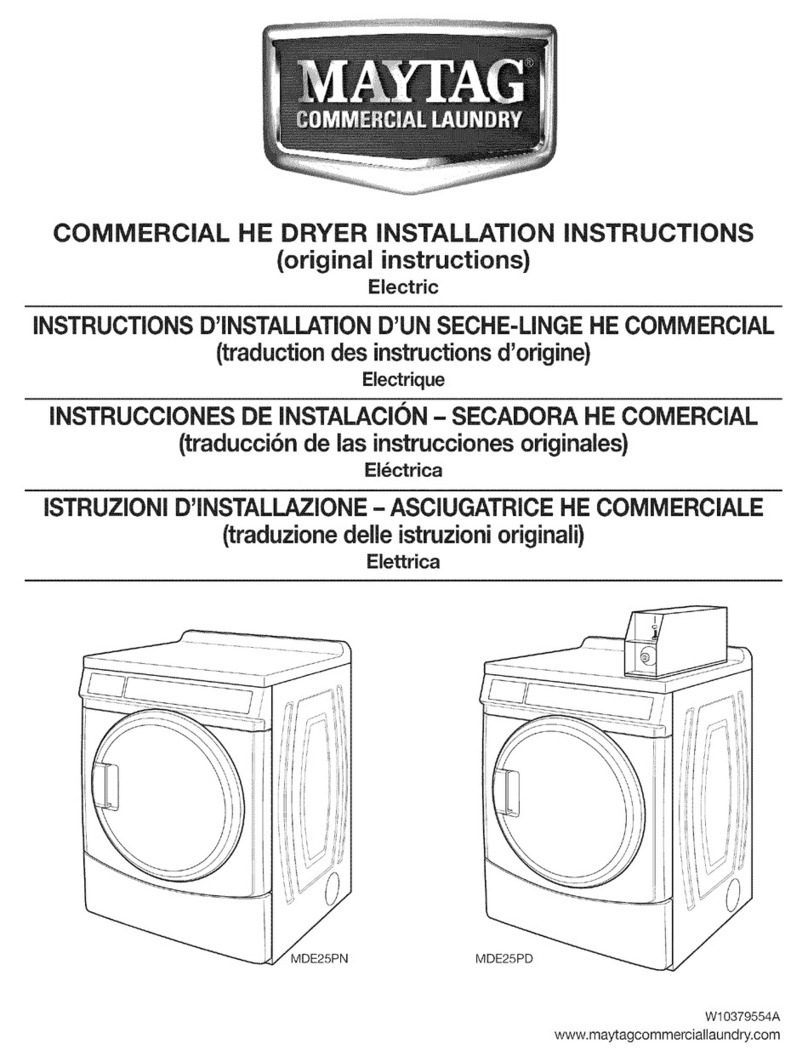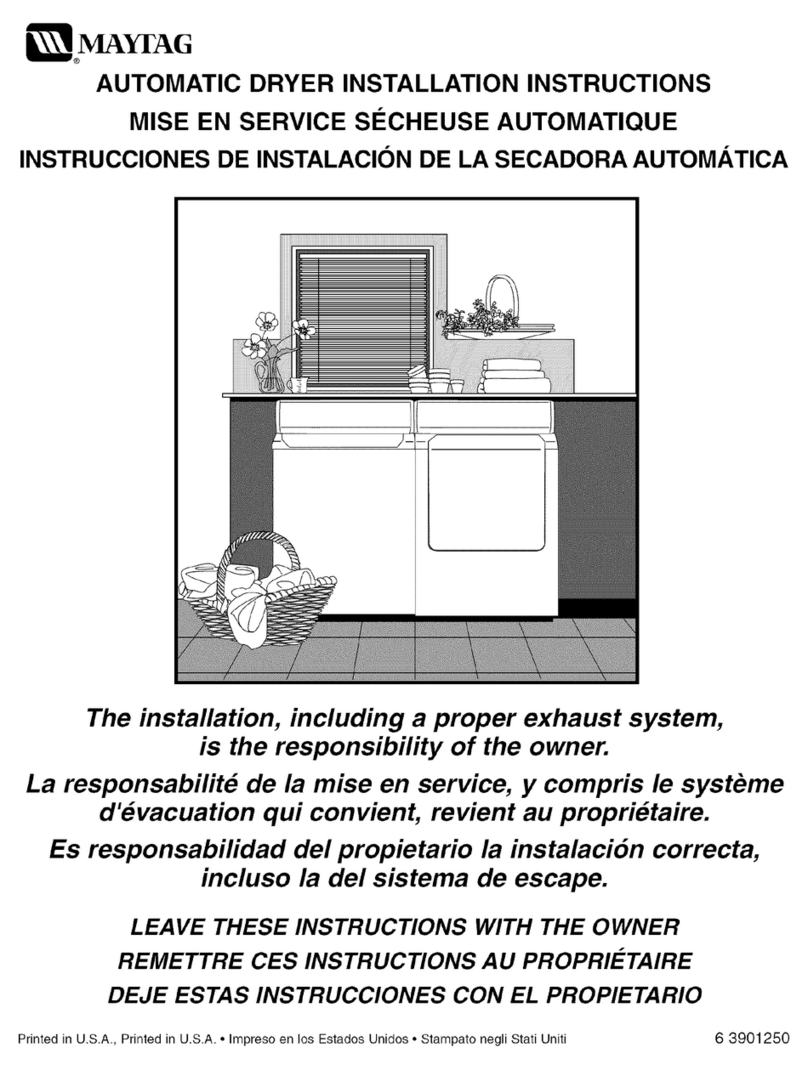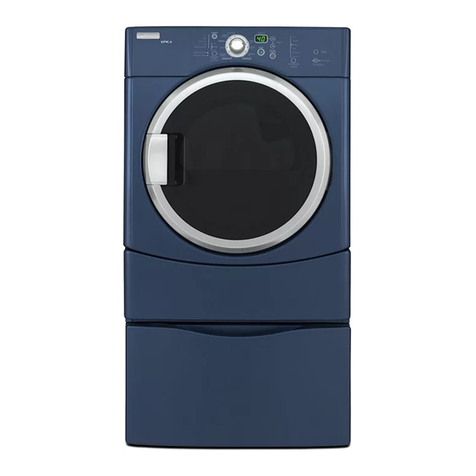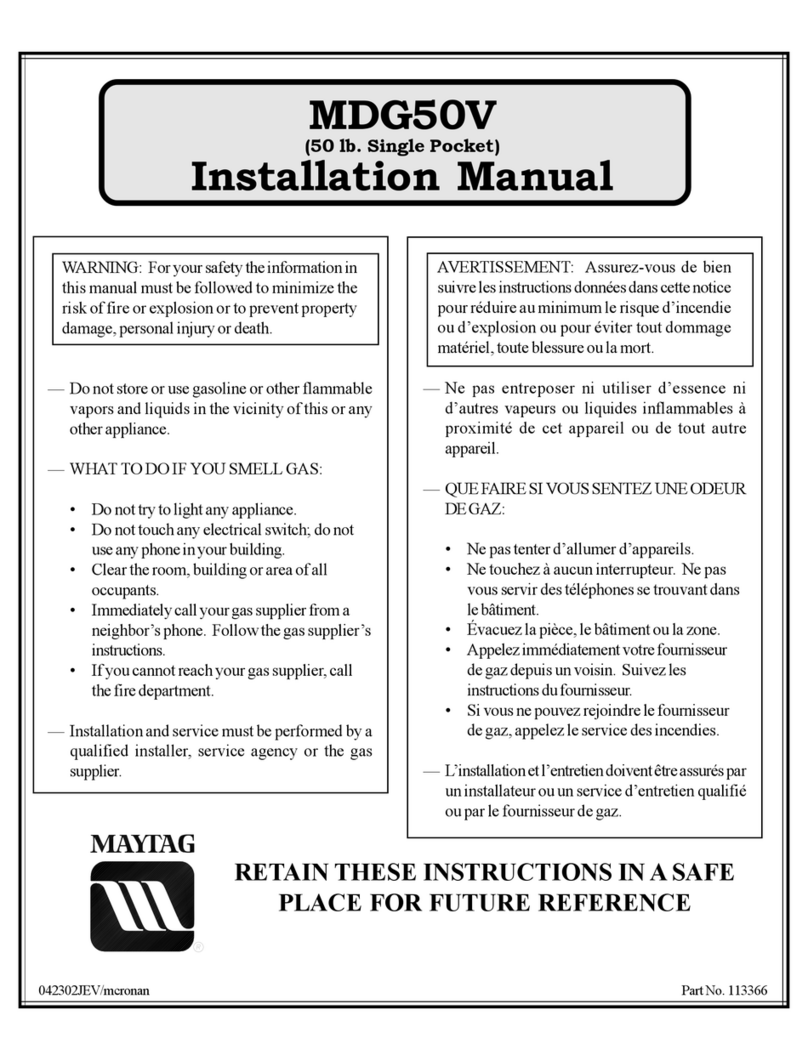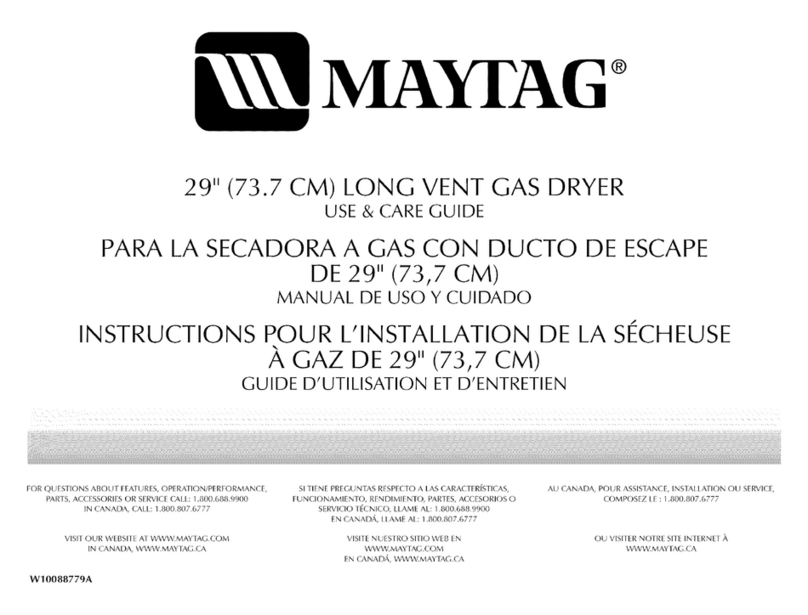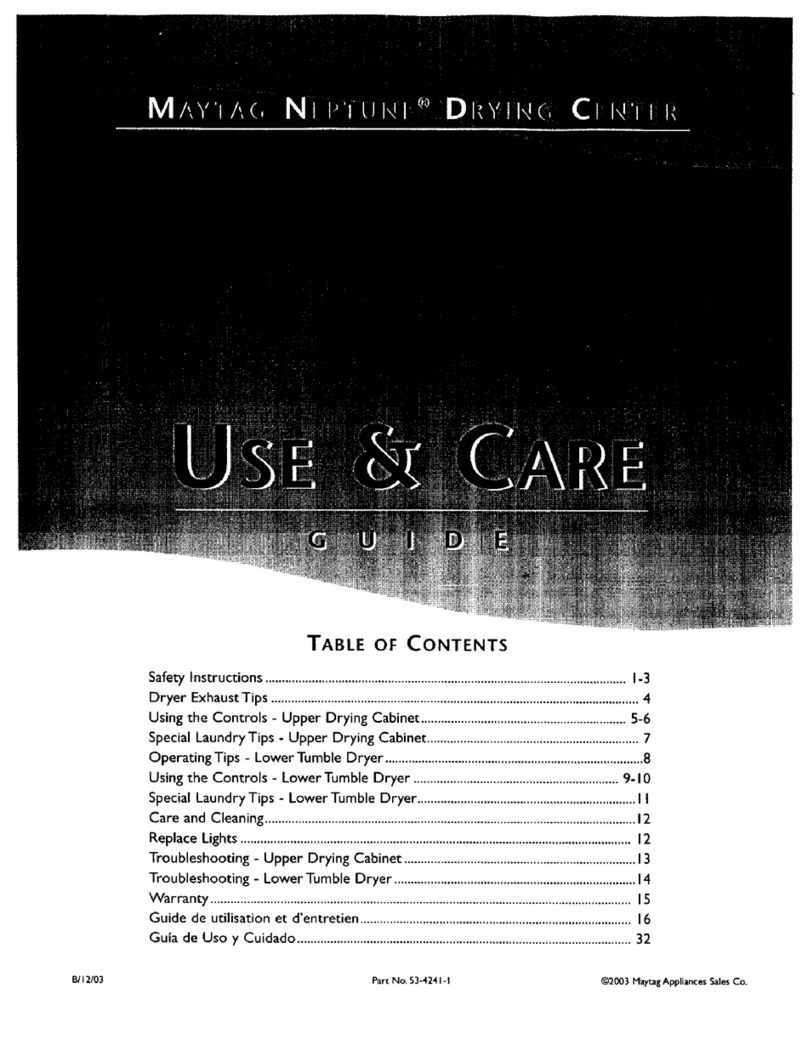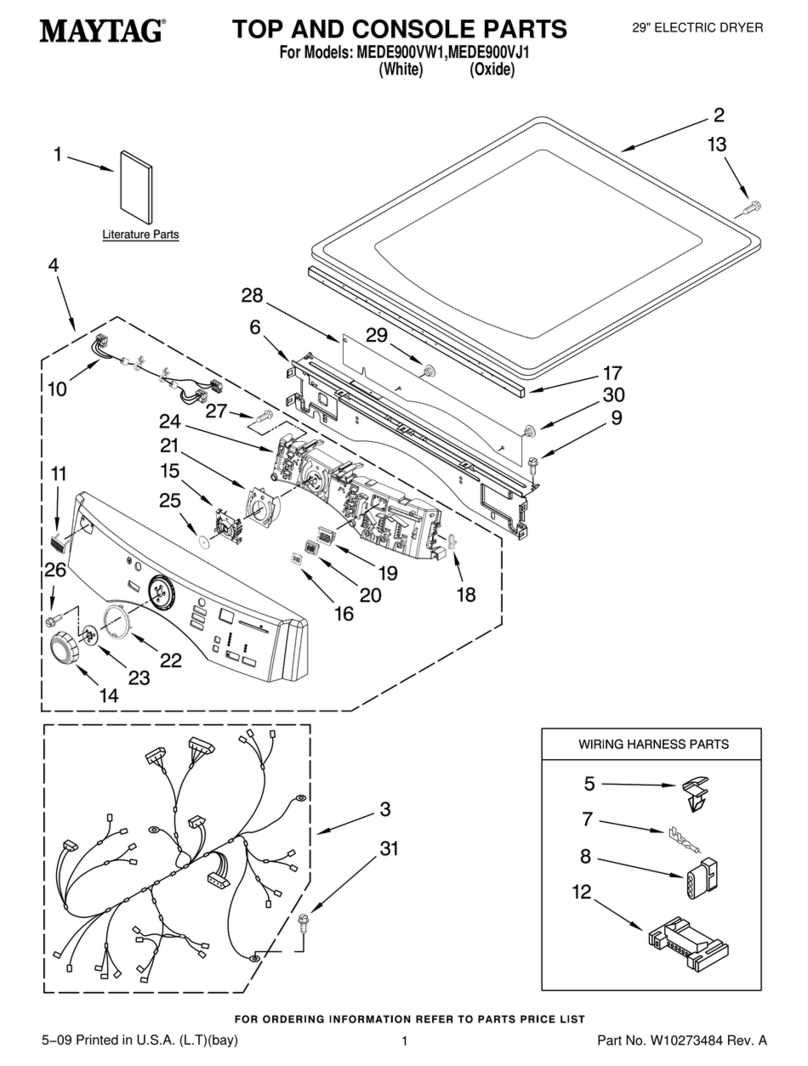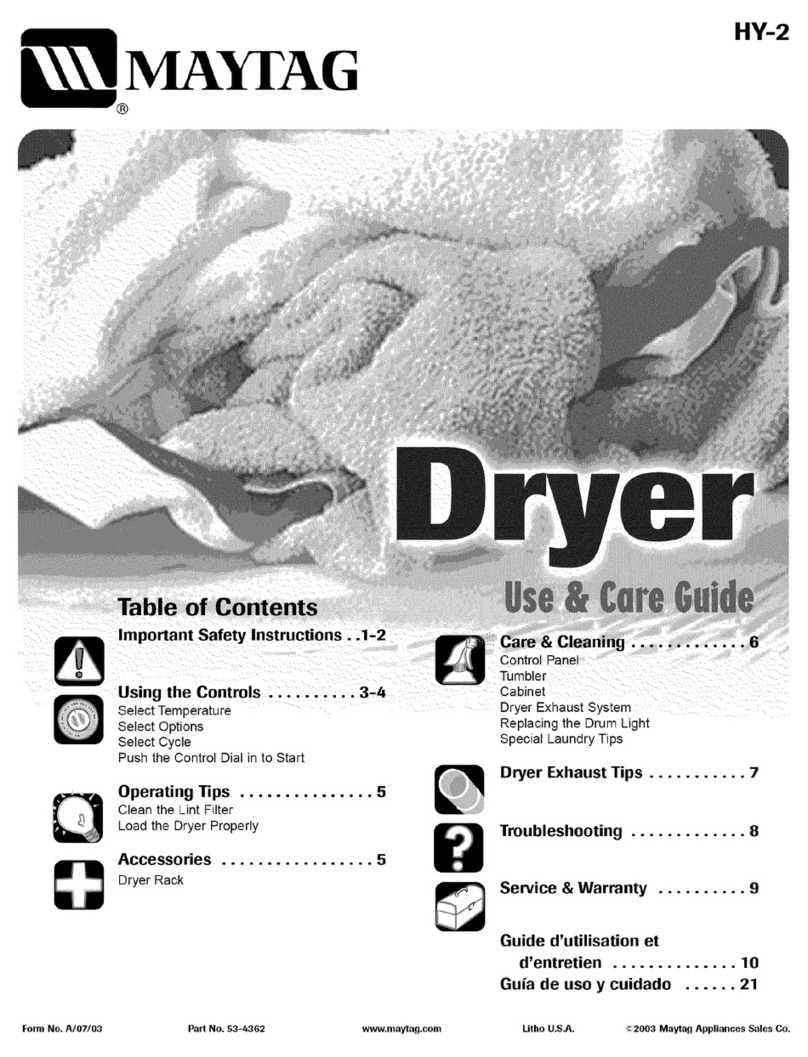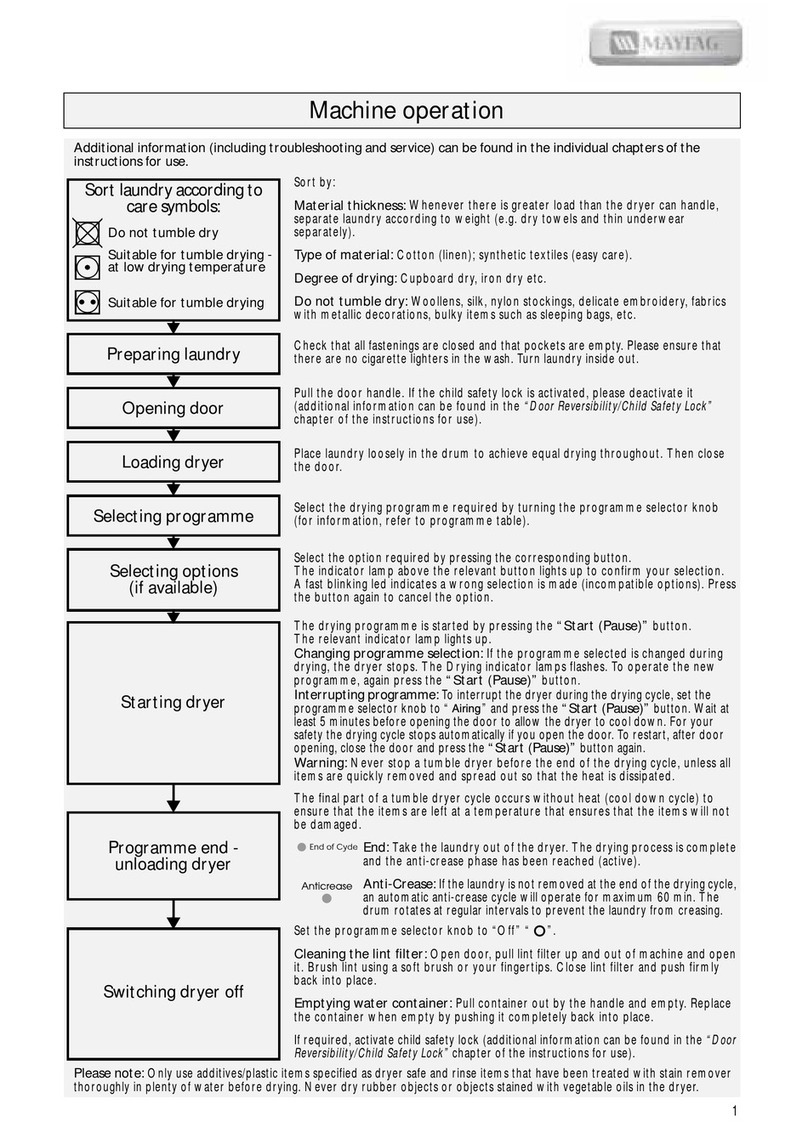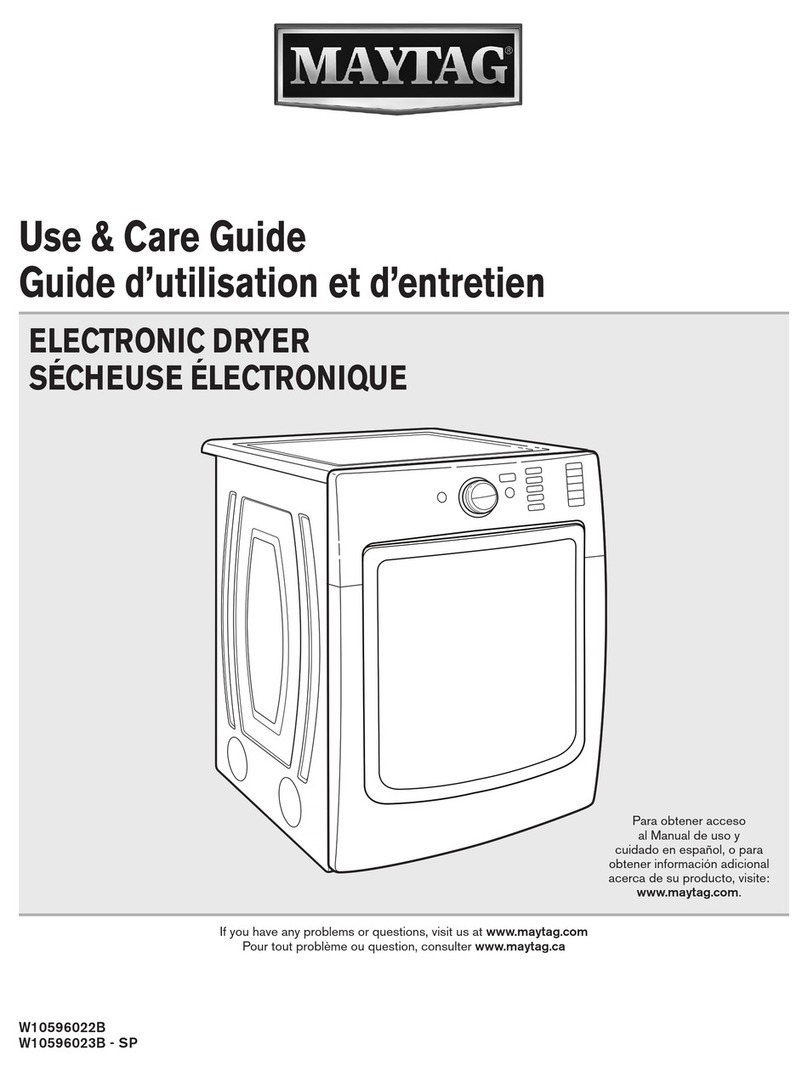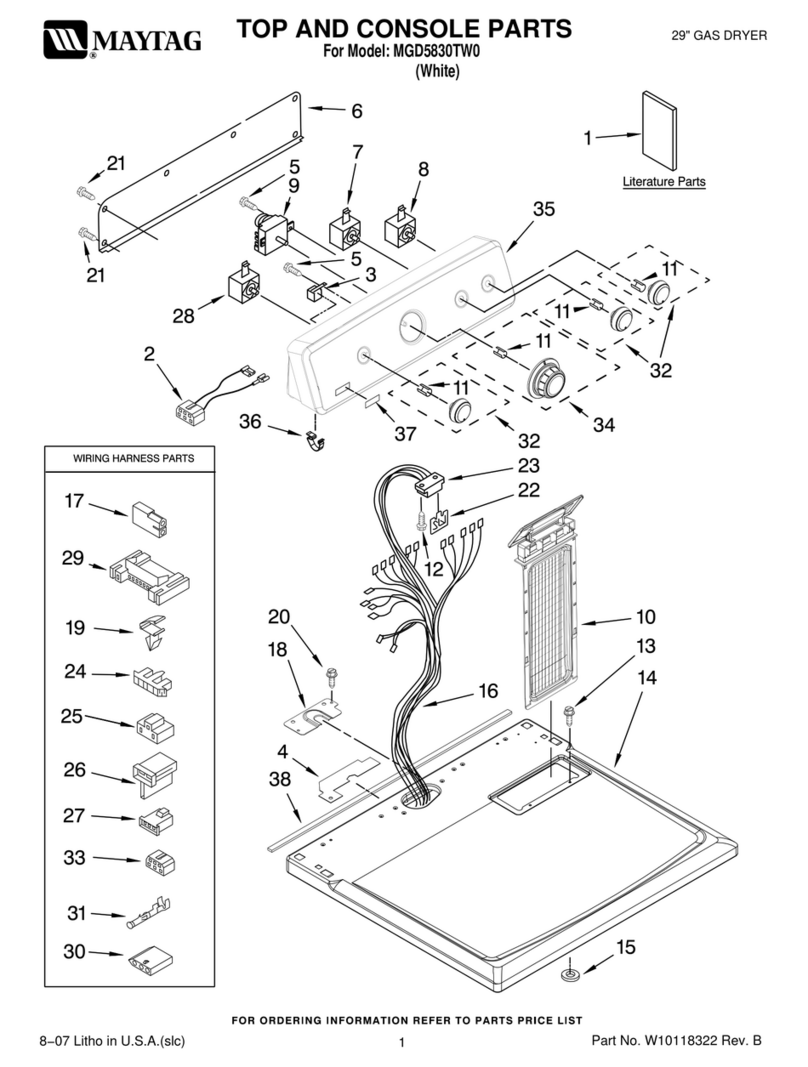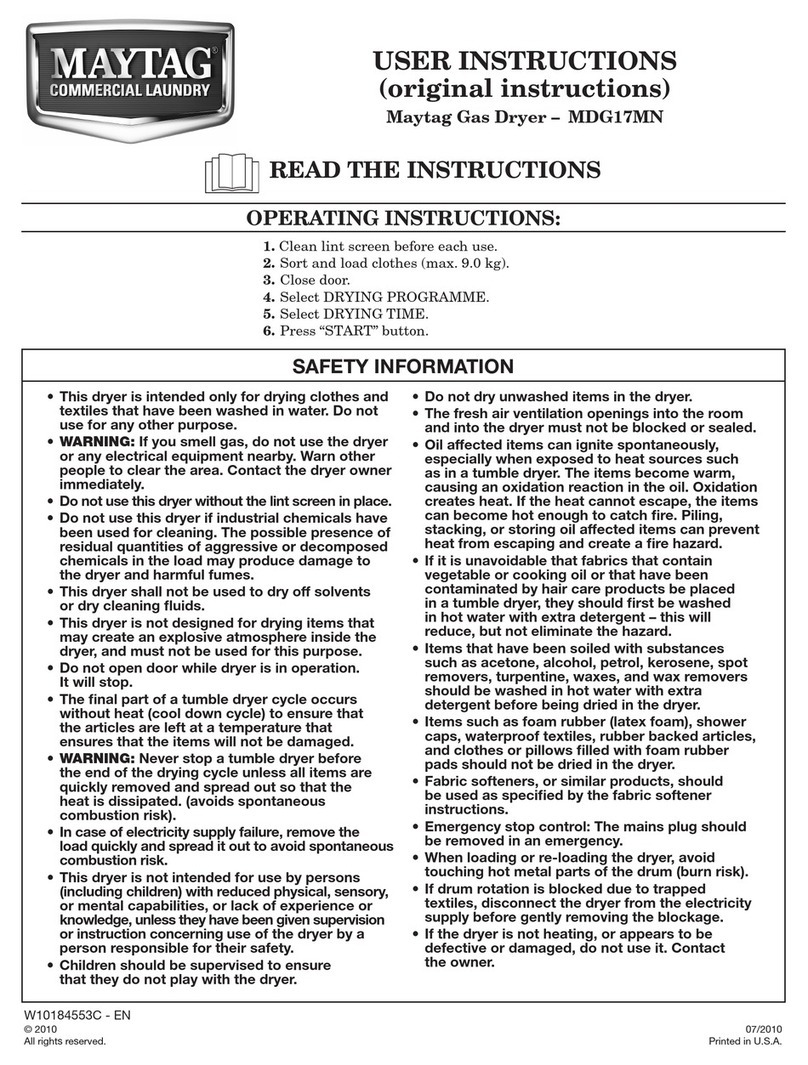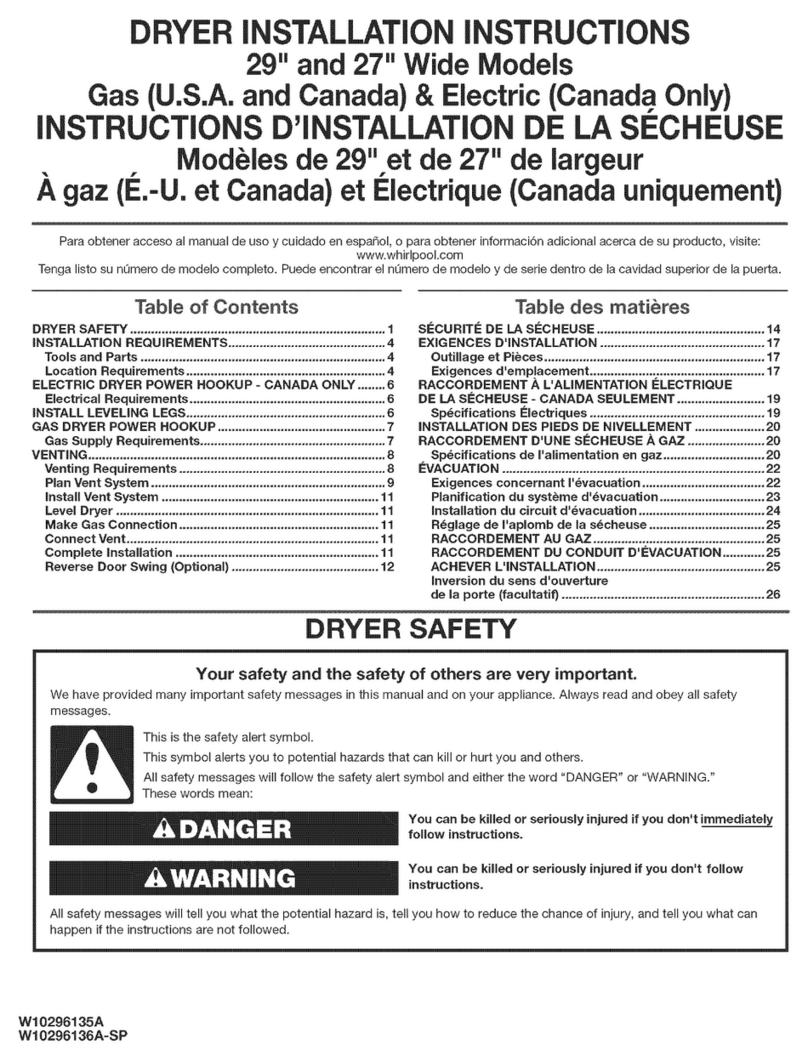
2
◆ TABLE OF CONTENTS ◆
DRYER SAFETY .....................................................................3
INSTALLATION INSTRUCTIONS ........................................4
TOOLS AND PARTS..........................................................4
LOCATION REQUIREMENTS ...........................................4
ELECTRICAL REQUIREMENTS - U.S.A. ONLY...................5
ELECTRICAL REQUIREMENTS - CANADA ONLY.............7
ELECTRICAL CONNECTION - U.S.A. ONLY.....................8
VENTING REQUIREMENTS.............................................14
PLAN VENT SYSTEM .......................................................16
INSTALL VENT SYSTEM...................................................17
INSTALL LEVELING LEGS................................................17
CONNECT VENT.............................................................18
LEVEL DRYER...................................................................18
REVERSE DOOR SWING.................................................18
COMPLETE INSTALLATION............................................20
DRYER USE .........................................................................21
STARTING YOUR DRYER................................................21
STOPPING, PAUSING OR RESTARTING ........................22
DRYING AND CYCLE TIPS..............................................22
STATUS LIG TS ..............................................................23
CYCLES ............................................................................23
MODIFIERS......................................................................24
OPTIONS.........................................................................25
END OF CYCLE SIGNAL..................................................25
C ANGING CYCLES, MODIFIERS AND OPTIONS........25
DRYING RACK OPTION .................................................26
DRYER CARE ......................................................................27
CLEANING T E DRYER LOCATION...............................27
CLEANING T E LINT SCREEN........................................27
CLEANING T E DRYER INTERIOR .................................28
REMOVING ACCUMULATED LINT................................28
VACATION AND MOVING CARE ..................................28
C ANGING T E DRUM LIG T.....................................28
TROUBLESHOOTING ........................................................29
ASSISTANCE OR SERVICE ..................................................31
WARRANTY .......................................................................32
◆ ÍNDICE ◆
SEGURIDAD DE LA SECADORA ....................................... 33
INSTRUCCIONES DE INSTALACIÓN ............................... 34
ERRAMIENTAS Y PIEZAS.............................................. 34
REQUISITOS DE UBICACIÓN ....................................... 35
REQUISITOS ELÉCTRICOS - SÓLO EN EE. UU............... 36
CONEXIÓN ELÉCTRICA - SÓLO EN EE. UU................... 38
REQUISITOS DE VENTILACIÓN..................................... 44
PLANIFICACIÓN DEL SISTEMA DE VENTILACIÓN ....... 46
INSTALACIÓN DEL SISTEMA DE VENTILACIÓN........... 47
INSTALACIÓN DE LAS PATAS NIVELADORAS.............. 48
CONEXIÓN DEL DUCTO DE ESCAPE............................ 48
NIVELACIÓN DE LA SECADORA ................................... 48
CÓMO INVERTIR EL CIERRE DE LA PUERTA................. 49
COMPLETE LA INSTALACIÓN........................................ 51
USO DE LA SECADORA .................................................... 51
PUESTA EN MARC A DE LA SECADORA ..................... 52
CÓMO DETENER, PAUSAR Y VOLVER A PONER
EN MARC A................................................................... 53
SUGERENCIAS DE CICLOS Y SECADO.......................... 53
LUCES DE ESTADO......................................................... 54
CICLOS ........................................................................... 54
MODIFICADORES .......................................................... 55
OPCIONES...................................................................... 56
SEÑAL DE FIN DE CICLO ............................................... 57
CAMBIO DE CICLOS, MODIFICADORES Y
OPCIONES...................................................................... 57
OPCIÓN DE ESTANTE DE SECADO............................... 58
CUIDADO DE LA SECADORA .......................................... 59
LIMPIEZA DEL LUGAR DONDE ESTÁ LA SECADORA... 59
LIMPIEZA DEL FILTRO DE PELUSA ................................ 59
LIMPIEZA DEL INTERIOR DE LA SECADORA ................ 59
ELIMINACIÓN DE PELUSA ACUMULADA .................... 60
CUIDADO DURANTE LAS VACACIONES
Y MUDANZAS................................................................ 60
CAMBIO DE LA LUZ DEL TAMBOR............................... 60
SOLUCIÓN DE PROBLE AS ............................................ 61
AYUDA O SERVICIO TÉCNICO ........................................ 63
GARANTÍA ........................................................................ 64
◆ TABLE DES ATIÈRES ◆
SÉCURITÉ DE LA SÉCHEUSE ..............................................65
INSTRUCTIONS D’INSTALLATION ..................................66
OUTILLAGE ET PIÈCES....................................................66
EXIGENCES D’EMPLACEMENT .......................................67
SPÉCIFICATIONS ÉLECTRIQUES - POUR LE CANADA
SEULEMENT ....................................................................68
EXIGENCES CONCERNANT L'ÉVACUATION ................69
PLANIFICATION DU SYSTÈME D’ÉVACUATION...........70
INSTALLATION DU SYSTÈME D’ÉVACUATION ............72
INSTALLATION DES PIEDS DE NIVELLEMENT...............72
RACCORDEMENT DU CONDUIT D’ÉVACUATION...... 72
RÉGLAGE DE L'APLOMB DE LA SÉC EUSE...................72
INVERSION DU SENS D'OUVERTURE DE LA PORTE....73
AC EVER L'INSTALLATION ...........................................75
UTILISATION DE LA SÉCHEUSE .......................................75
MISE EN MARC E DE LA SÉC EUSE .............................76
ARRÊT, PAUSE OU REMISE EN MARC E.......................77
CONSEILS POUR LE SÉC AGE ET LES
PROGRAMMES ...............................................................77
TÉMOINS LUMINEUX.....................................................78
PROGRAMMES ...............................................................78
MODIFICATEURS............................................................79
OPTIONS.........................................................................80
SIGNAL DE FIN DE PROGRAMME .................................80
C ANGEMENT DES PROGRAMMES, MODIFICATEURS
ET OPTIONS....................................................................81
OPTION DE GRILLE DE SÉC AGE .................................81
ENTRETIEN DE LA SÉCHEUSE ...........................................82
NETTOYAGE DE L'EMPLACEMENT DE LA SÉC EUSE...82
NETTOYAGE DU FILTRE À C ARPIE .............................82
NETTOYAGE DE L’INTÉRIEUR DE LA SÉC EUSE...........83
RETRAIT DE LA C ARPIE ACCUMULÉE.........................83
PRÉCAUTIONS À PRENDRE POUR LES VACANCES
ET AVANT UN DÉMÉNAGEMENT..................................83
C ANGEMENT DE L’AMPOULE D’ÉCLAIRAGE
DU TAMBOUR................................................................83
DÉPANNAGE .....................................................................84
ASSISTANCE OU SERVICE .................................................86
GARANTIE .........................................................................87


